Archive for the “A” Category
Encyclopedia: Gambling in America - Letter A
The four Maritime or Atlantic provinces of Canada—New Brunswick, Newfoundland, Nova Scotia, and Prince Edward Island—joined together in 1976 to form the Atlantic Lottery Corporation. The purpose of the corporation is to serve as a central marketing agency for lottery products in the provinces. An eight-member board of directors is composed of two representatives from each province. The corporation offers several different games, including traditional weekly and daily draws, instant games, and lotto games.
<
 No Comments »
No Comments »
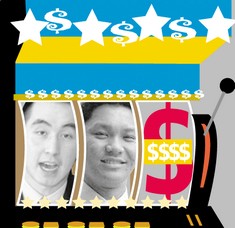 From my studies and personal observations, I believe that the Asian continent has produced the world’s best gamblers. Persons of Asian heritage attack the games of the casinos all over the world with a vigor and zest not found coming from other ethnic groups. The explanations for Asians’ love of gambling are explored in Appendix A in the section “The Best Gamblers in the World.” Here we consider the irony that the most prevalent religions of the Asian continent—Muslim, Hindu, Buddhist, and Shinto—all frown upon gambling activity. The religious activities have greatly limited the scope of legal gambling that is permitted, although there are exceptions to the rule. Many countries permit lotteries and horse racing. The major jurisdictions—indeed the two most populous countries in the world, China and India—totally ban gambling, however. (The enclave known as Macao is now part of China, and its casino gambling will be reviewed over the next few years by authorities in an effort to decide whether it will stay or go. See Macao.) India has allowed gambling boats, and there are also horse racing tracks and lotteries, but there is no casino gambling. From my studies and personal observations, I believe that the Asian continent has produced the world’s best gamblers. Persons of Asian heritage attack the games of the casinos all over the world with a vigor and zest not found coming from other ethnic groups. The explanations for Asians’ love of gambling are explored in Appendix A in the section “The Best Gamblers in the World.” Here we consider the irony that the most prevalent religions of the Asian continent—Muslim, Hindu, Buddhist, and Shinto—all frown upon gambling activity. The religious activities have greatly limited the scope of legal gambling that is permitted, although there are exceptions to the rule. Many countries permit lotteries and horse racing. The major jurisdictions—indeed the two most populous countries in the world, China and India—totally ban gambling, however. (The enclave known as Macao is now part of China, and its casino gambling will be reviewed over the next few years by authorities in an effort to decide whether it will stay or go. See Macao.) India has allowed gambling boats, and there are also horse racing tracks and lotteries, but there is no casino gambling.
In the area known as Asia Minor (and the Middle East), Turkey has had casinos since 1969. The legality of the facilities has been under constant scrutiny, however, and the gambling has not been able to be focused toward any societal goals such as economic development. For many decades before the 1970s, Lebanon offered the finest casino in the Middle East. Internal warfare totally destroyed the entertainment value of gambling in the country. When the Palestine state gained a measure of sovereignty in the 1990s, it authorized a casino that sought much of its patronage from Israeli citizens.
Nepal has small casinos for foreign visitors to the hotels in Kathmandu. Most of their patrons are Indians. The only other casinos on the soil of mainland Asia are in Korea. Casinos have operated there since 1967 as a way to attract foreign capital. Local residents are not permitted into the casinos. Among the foreign patronage are the 40,000 U.S. military personnel stationed in the country.
A government organization in the Philippines runs twelve casinos. Additionally, the organization has contracts with foreign investors who operate private casinos in several large hotels. The Philippines have not been subjected to the religious restraints of most of the Asian countries, as the islands were under Spanish and U.S. control with strong, gambling-tolerant Catholic influences for nearly four centuries before independence came in 1946.
Malaysia offers an interesting casino environment. The Genting Highlands resort, located thirty-five miles from the capital city of Kuala Lumpur, is the only permitted casino. It has been in operation since 1970, with a complex of 3,500 hotel rooms and 200,000 square feet of casino space. Until the Las Vegas MGM and Foxwoods in Connecticut opened casinos in the 1990s, Genting Highlands was the largest casino in the world. (Indeed, when the Pequot tribe of Native Americans wished to build Foxwoods, it was refused financing by every U.S. source because it was too big a risk. The tribe eventually received its loan from the Genting Highlands Gaming Corporation.) As the Muslim faction among the Malaysian population has considerable political influence, it has permitted the casino only under the condition that only non-Muslim Malaysian residents may enter the casino. The Muslim religious organization is allowed to patrol the casino with a police arm. It has the authority to drag out any local Muslims it finds, and the religious authorities mete out punishment.
Japan offers many gambling experiences; however, casinos as such are not permitted. The Japanese government lottery is the largest single lottery in the world in terms of revenues. There is also horse racing. Unique forms of gambling include pari-mutuel wagering on bicycle and motorboat racing. Although there are no gambling halls with casino table games, there are 18,000 gambling halls featuring machines. Most of the machines are pachinko machines (see Japan and Pachinko).
<
 No Comments »
No Comments »
Aruba has been the most successful casino jurisdiction in the southern Caribbean. The island, now an independent nation, lures tourists who enjoy the warm climate along with gaming opportunities. Casinos reach into South America, particularly to Venezuela, for players. Many people also come to Aruba from the United States via the gambling junkets offered by the casinos. The lack of adequate lodging, however, limits the potential for gaming development. Profit margins are small, as expenses are very large. Also the government extracts a 2 percent drop tax, meaning that when a player buys $100 in chips, the casino is obligated to pay a tax of $2. That amount is rather high. In addition, there is a gross gaming tax.
The casinos of Aruba are self-regulated; the island nation has no gaming board. The Ministry of Justice provides inspectors who monitor the doors of the casinos to ensure that no persons younger than eighteen years of age enter.
<
 No Comments »
No Comments »
In terms of legal gambling, Arkansas is best known for the Oaklawn Park horse racing track in Hot Springs and also for a dog track in West Memphis. Yet the real story of gambling in Arkansas involves wide-open illegal casinos in Hot Springs (in Garland County) that operated for over a century with connections to many of the leading mobsters in the land. In the mid-1950s, reform governor Orval Faubus sought to close down the gaming. Local Garland County judges overruled his efforts, however, and Faubus dropped the issue. After a staunch antigambling Baptist minister was elected to the legislature, the issue was reopened. He pushed a resolution demanding that the governor shut down the casinos. In 1963 the governor responded. After he did so, the citizens of Hot Springs circulated petitions to legalize casinos. The question was put on the ballot in 1964. The campaign for casinos was led by the local chamber of commerce; however, it was opposed by both Faubus and his 1964 opponent, Winthrop Rockefeller. Arguments that the state could experience a financial windfall from casinos fell on deaf ears, and the voters defeated casinos by a vote of 318,000 to 215,000. The doors of the casinos have been closed since then, but the casino proponents keep trying to win public support. In 1984, another petition was presented to the voters. Again, Garland County residents led the campaign. The state’s young governor, Bill Clinton, opposed it. His wife, Hillary, led the campaign against casinos with a statewide speaking tour. Voters said no by a 71 percent to 29 percent margin. In 1996, voters said no again by the same overwhelming margin. This time, the appeal had been not to produce state revenues but rather to meet the competition from riverboat casinos in surrounding states. The dreams of returning to the glory days of gangsters and excitement in Hot Springs remain, but all the gambling is confined to the short racing season each summer.
A proposal was put forth in the 2000 election that would have allowed six counties to have local option votes on casino gambling. The voters of Arkansas defeated casinos one more time.
<
 No Comments »
No Comments »
In 1908, all gambling activity was banned in Arizona Territory in an effort to win congressional support for statehood. By mid-century, the state of Arizona had legalized pari-mutuel horse-race and dog-race betting and had also established active charity gambling operations. The state has also had a lottery since 1991. When Las Vegas Nights were authorized, commercial gambling suppliers actually took slot machines around to the events. The state also permitted the sale of slot machines, and in the 1980s, several businesses were importing used machines from Nevada and repairing and reselling them throughout the country. The businesses were supplying many of the machines to illegal operators, yet the state took no direct actions to stop the sales.
The many Native American tribes of the state were therefore set back when the state refused to negotiate a compact for casino gambling. After several years of legal maneuvering, the tribes won a federal court order mandating negotiations, and in the early 1990s tribal bingo halls were converted into tribal casinos. Eventually over twenty tribes established casinos; the largest ones, in the Phoenix area, are operated by the Ft. McDowell, Ah-Chin, and Salt River Pima tribes.
<
 No Comments »
No Comments »
Argentina has all major forms of gambling: casinos, slot machine parlors, lotteries, bingo halls, racetracks, and a variety of lotteries. The 34 million citizens occupy a land base about one-third the size of the United States. The country is divided into twenty-eight provinces, plus the national district of Buenos Aires City. Both the provinces and the national government have authorized lotteries, casinos, and other forms of gambling. Until the 1990s, the government operated almost all of the gambling; since then a privatization drive has brought many new casino organizations to the country, upgrading that form of gambling. Until very recently, no casino gambling was allowed in the national city of Buenos Aires; however, a dockside ship now offers over 300 slot machines and nearly fifty tables for gamers.
Casino gaming has been common in Argentina, starting in colonial days of the eighteenth and early nineteenth centuries when viceroys from Spain governed the land. At that time and even after national independence in 1810, casinos were privately owned and locally licensed. This structure of minimal regulation and local control changed drastically in the mid-twentieth century.
As in most Latin American politics, a chief executive and his appointed council, as opposed to a broad representative legislative chamber, control
government. This pattern of executive rule derives from colonial traditions and cultural expectations. Military governments also have been common in the region. Argentina’s governmental structures fit these patterns. In 1943, General Edelmiro Farrell assumed the role of “keeper of the national conscience” after deposing the civilian government. His selected council included General Juan Peron, who was the minister of war, the vice president, and the secretary of labor. General Peron succeeded to the presidency as the head of the new Argentine Labor party in 1946. His election resulted from widespread support from the working classes and the Catholic Church. He remained the leader and virtual dictator until other military officers deposed him in 1955. Many changes occurred under the leadership of Farrell and Peron, including the structure of casino operations. Peron advanced industrialization programs requiring increased national control at the expense of provincial powers. He also fostered public ownership of enterprise.
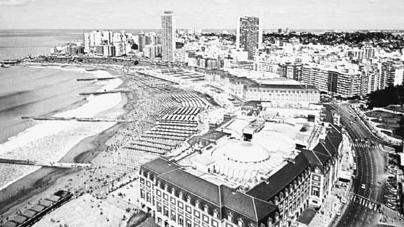
A view of Mar Del Plata, the largest casino in South America, located 200 miles south of Buenos Aires.
In 1944, a presidential decree closed all private casinos in Argentina. The national government controlled all casinos from then on. One consequence of this action, remaining to this day, was the closure of casinos in the national capital city of Buenos Aires and its suburbs. This decision influenced the development of South American gaming. Casinos in Argentina, Uruguay, Chile, Ecuador, Colombia, and Surinam now market their properties to wealthy Buenos Aires players. The other major target area is Brazil, which also lacks legal casinos.
The National Lottery Administration (La Lotteria de Beneficial) has operated a national drawing since 1893. It now oversees the publicly owned casinos for the national government. In 1947 the administration created a casino commission to direct operations. The commission consists of representatives of the Ministries of Finance and Labor and the National Bank.
The first casinos authorized to be part of this organization opened in the beach resorts in the province of Buenos Aires, about 200 miles from the capital city. Casinos operating as private casinos in Mar del Plata, Necochea, and Miromar (December 1944) continued as national government casinos. In 1945, the government nationalized the casino at Termas de Rio Hondo, a hot springs resort in the province of Santiago del Estero. A decree in 1946 reiterated that all casinos were under the jurisdiction of the national government but recognized that provinces could prohibit gaming within their borders.
Despite a decree in 1947 that placed the National Lottery Administration under the minister of the interior, two years later the minister of finance assumed the responsibility. Casino revenues were to be spent on social work, health, and urban sanitation programs. Later additions to the list of gaming recipients were schools, universities, local governments, tourism programs, medical foundations, and the Eva Peron Foundation. The government set admission charges for players and fees for exchanging checks and purchasing chips. In 1951, the government assessed a fee of 0.5 percent of the drop but later eliminated it.
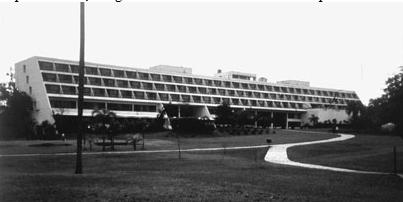
The international hotel overlooking the Iguasu Falls on the Argentina-Brazil border.
The national casino system expanded by nationalization of a private casino in Mendoza in 1947 and the creation of a casino annex at Mar del Plata in 1949. In 1954, casinos opened at the snow skiing and lakes resort of Bariloche in Rio Negro Province and at Termas de Reyes in Jujuy Province. Another casino opened at Termas de Rosario de la Frontera in Salta Province in 1959.
In 1963, a national casino opened at the edge of the great Iguazu Falls in Misiones Province. Casinos came to Alta Gracia and La Cumbre in Cordoba Province in 1971. The provinces of Corrientes and Chaco and the city of Parana in Entre Rios Province received authorizations for casinos in 1972. In the same year, a new national casino opened in the seaside resort of Piromar in Buenos Aires Province. Later in the decade, the remote coastal cities of Rivadavia and Puerto Madryn in Chubut Province and the interior city of Tandil in Buenos Aires Province established casinos. A seasonal casino in the oceanside resort of Las Grutas in Rio Negro Province also began operations.
After the fall of the final Peron government in the mid-1950s, the interior provinces tried to reassert autonomy over many public policy areas previously dominated by Peron officials. Several provinces wanted their casinos back.
In 1960, the national casino at Mendoza closed, and the provincial government assumed control of gaming. In 1961, the casino at Termas de Rio Honda was transferred to the provincial government of Santiago del Estero. In 1962, a presidential decree authorized provincial participation in all revenues from the national casinos. Subsequently, the provinces acquired the casinos in Salta and Jujuy. These and other provincial governments started province-operated casinos. The interior provinces of San Luis, San Juan, La Rioja, Tucuman, Santa Fe, Misiones, and Corrientes now have such casinos.
A movement toward privatization on a national level began in the mid-1980s. The public treasuries of the nation faced trouble from Argentina’s continuing economic crisis. The incentives for generating revenues by sales of casino properties were present.
The central government negotiated with the province of Rio Negro to transfer the national casino at Bariloche. In the early 1980s, the government of Mendoza Province had been anxious for resort developments. Ernesto Lowenstein saw the possibility of developing a world-class ski resort at Las Lenas on the edge of the Andes. In exchange for taking a risk with his development, he asked for a casino concession. The province was happy to comply with his desires. The resort opened in 1985, and two years later, a casino began operations. The Lowenstein Resort Company owns the casino, which Casinos Austria operates under a management contract. In 1989, the provincial government granted a second private casino concession to the developers of the new Ora Verde Hotel in Mendoza City. These two private casinos, the first in over forty years in Argentina, were the impetus for the privatization of the existing government casinos at both the national and provincial levels. Other new private casinos were also authorized, and the Mirage organization of Las Vegas was instrumental in starting a major facility at Iguasu Falls at the Brazilian border.
The National Lottery Administration also controls and administers other gaming. A major track near Buenos Aires offers horse racing. Three tracks along with fifty offtrack betting facilities had a total handle of around $300 million a year in 1997, the most recent year for which information is available. Another form of legal gaming is parlay betting on soccer games. The administration also offers various lottery products. Additionally, the provincial governments run lottery operations.
 No Comments »
No Comments »
Antigua and Barbuda, in the Leeward Islands of the West Indies, constitute an island nation that was formerly under the control of Great Britain. The government allows casino gambling, bingo halls, horse-race betting, a lottery, offtrack betting, and sports betting on the Internet. There are five casinos in the capital city of St. John’s and one in the city of Deep Bay. The minister of finance licenses all the casinos. A license may be given to any person who owns a hotel that markets rooms to tourists.
The Antiguan government encourages casino development and is willing to offer new licenses to those wishing to start casinos. Larger hotels pay an annual licensing fee of $300,000; smaller hotels pay $100,000. Additionally they pay a tax of 15 percent of their gaming revenue. Although local residents may come to the casinos, the casinos are prohibited from advertising gaming to the local public.
In 1985, one of the largest properties, the Halcyon Cove, instituted a small gambling junket program in which tourists fly in from cities in the United States on inclusive tours. Because checking credit players incurs an element of risk, the Halcyon Cove does not subscribe to a credit check service based in the United States (unlike other junket destinations in the Caribbean). Therefore, to ensure against potential problems, the hotel has received written guarantees from junket organizers, who cover debts owed by the players they bring to the casino.
In operating the casinos on Antigua, the gaming management must realize that vacationers do not travel to the island in order to gamble. They come to relax, rest, and enjoy the weather and scenery. Gambling is only one amenity to fulfill the entertainment needs of the guests. It is not a major profit center for the management or government.
<
 No Comments »
No Comments »
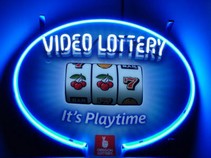 Alberta can lay claim to having the first legalized casino gaming in Canada, albeit in a temporary form. In 1967 the provincial government initiated several laws that seemed to open the door to casino games even though they were forbidden by the Penal Code. In the summer, during the Edmonton Exhibition, the Silver Slipper Saloon was opened as part of the two-week celebration. The general manager of the exhibition later indicated that he had taken payoffs from the carnival company that ran the games, that is, the Silver Slipper. Amendments to the national code in 1969 helped regulate Alberta gaming. The attorney general took control over licensing charitable bingo games and raffles. In 1975, the attorney general’s office opened the door to casinos once again as it first approved a casino for a charity event supporting a summer camp. A license was then given for a casino at the Calgary Stampede. A flood of applications for casino events overwhelmed the attorney general, and he quickly created a special Gaming Control Section to regulate the gaming. Rules were set into place over the next two years. In 1981, a new Alberta gaming commission took over all licensing powers. Alberta can lay claim to having the first legalized casino gaming in Canada, albeit in a temporary form. In 1967 the provincial government initiated several laws that seemed to open the door to casino games even though they were forbidden by the Penal Code. In the summer, during the Edmonton Exhibition, the Silver Slipper Saloon was opened as part of the two-week celebration. The general manager of the exhibition later indicated that he had taken payoffs from the carnival company that ran the games, that is, the Silver Slipper. Amendments to the national code in 1969 helped regulate Alberta gaming. The attorney general took control over licensing charitable bingo games and raffles. In 1975, the attorney general’s office opened the door to casinos once again as it first approved a casino for a charity event supporting a summer camp. A license was then given for a casino at the Calgary Stampede. A flood of applications for casino events overwhelmed the attorney general, and he quickly created a special Gaming Control Section to regulate the gaming. Rules were set into place over the next two years. In 1981, a new Alberta gaming commission took over all licensing powers.
As gaming developed, Alberta adopted the model used in British Columbia. Charities could have casino events, but they had to be held in permanent facilities that were operated by private parties. In the 1990s, the number of such facilities grew to nearly a score. There are five casinos in Edmonton; four in Calgary, and others spread around the province. Until 1998 they were not allowed to have slot machine gaming, and the charities paid a fixed fee for having an event. When the government installed machines, a new revenue division based upon play was instituted. As the government owns the machines, it keeps a majority of machine revenues. Although no serious consideration is being given to the creation of large commercial casinos, proposals have been made for wide-open, large-scale casino gaming on the First Nations reserve lands.
Alberta has many other types of gambling, including all forms of pari-mutuel operations, both on-track and offtrack. Raffles and pull tabs are sold by charities. The most prevalent form of gambling, however, is found in the bars and taverns of the province. By 1999 more than 6,000 video lottery terminals were operating in 1,200 locations, producing about $300 million in revenue, which is about 70 percent of the gaming revenue produced in the province. In that year the popular machines (which provide an average gaming revenue of $50,000 a year) accounted for a per capita gaming participation of about $1,300 per adult, the largest in Canada and North America, with the exception of Nevada. Studies have also revealed that Albertans have the highest rate of problem gambling in Canada. Efforts to ban the terminals have been concerted, with local elections called in 1998 in most of the cities. Only in a few smaller cities did the voters choose to ban the machines.
<
 No Comments »
No Comments »
Alaska – Gambling in America
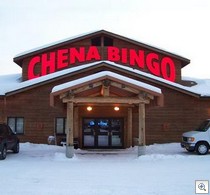 Native Alaskans and Native Americans in Alaska conduct bingo operations. There are also many bingo games sponsored by charitable organizations. Much of the revenue for the games’ sponsors comes from the sale of pull-tab tickets. Alaska permits many raffle-type games for a variety of nonprofit interests. One of the most interesting games allows people to pick the time for the first breakup of ice floes in the spring each year. In recent years there has been interest in developing some casino gambling. The proposals for increased gambling have not found support in the legislature, however, or among the general population. In 1990, a ballot initiative to permit limited stakes casino games in bars and taverns was soundly defeated by a 60 percent to 40 percent margin.
< Native Alaskans and Native Americans in Alaska conduct bingo operations. There are also many bingo games sponsored by charitable organizations. Much of the revenue for the games’ sponsors comes from the sale of pull-tab tickets. Alaska permits many raffle-type games for a variety of nonprofit interests. One of the most interesting games allows people to pick the time for the first breakup of ice floes in the spring each year. In recent years there has been interest in developing some casino gambling. The proposals for increased gambling have not found support in the legislature, however, or among the general population. In 1990, a ballot initiative to permit limited stakes casino games in bars and taverns was soundly defeated by a 60 percent to 40 percent margin.
<
 Even though Mobile, the first city of Alabama, has had a rich history of pirates, houses of ill repute, Mardi Gras celebrations, and gambling dens of inequity, most sinful activities in the state have been effectively suppressed in modern times. One major exception was the illegal enterprises of Phoenix City, which during and after World War II catered to a clientele made up mostly of soldiers from nearby Fort Benning. A major cleanup was instituted in the 1950s by state attorney general John Patterson. Patterson was propelled into the crackdown activity after his father, a candidate for attorney general at the time, was murdered by local mobsters who were running the town. In 1954 John Patterson was elected in place of his father. Even though Mobile, the first city of Alabama, has had a rich history of pirates, houses of ill repute, Mardi Gras celebrations, and gambling dens of inequity, most sinful activities in the state have been effectively suppressed in modern times. One major exception was the illegal enterprises of Phoenix City, which during and after World War II catered to a clientele made up mostly of soldiers from nearby Fort Benning. A major cleanup was instituted in the 1950s by state attorney general John Patterson. Patterson was propelled into the crackdown activity after his father, a candidate for attorney general at the time, was murdered by local mobsters who were running the town. In 1954 John Patterson was elected in place of his father.
Gambling activity resurfaced in the 1980s; however, it now operated on a legal basis—for the most part. Charitable games were permitted under the control of local governments, and the state also authorized the establishment of dog- and horse-race betting. The largest track in the state opened near Birmingham, and it pioneered an unusual event. The track featured both dog and horse racing on the same day and on the same card. The experiment with racing was not overly successful, as it was initiated just a few years before the state of Mississippi authorized commercial casino gambling as well as Native American casino gambling. Several of these facilities were near the Alabama border. Also, two other states bordering Alabama—Florida and Georgia—started very active lottery games that drew players from Alabama. The Alabama Porch Creek tribe of Native Americans led by Eddie Tullis reacted to the new gambling ventures by creating two large bingo halls and by seeking a compact for casino games. State officials refused to negotiate a casino compact, but the tribe began using gambling machines anyway.
As the twentieth century ended, the legislature gave serious consideration to legalizing new forms of gambling, including table games, and machine gambling for racetracks. There are now four dog tracks in existence, as Birmingham closed its horse-race activities. The legislature was able to authorize a public vote on the question of having a state lottery. In 1998, the governor was elected on a platform that included the lottery proposal. In October 1999, however, the voters of the state shocked not only Alabama but also the whole nation when they said no to the lottery by a vote of 54.3 percent to 45.7 percent. The lottery proposal was designed to duplicate the Georgia experience in that it designated revenues for a plan of free college scholarships for Alabama high school graduates with good records. With the negative vote, Alabama became only the second state (the other being North Dakota) to receive a negative vote on a state-operated lottery proposal.
<
 No Comments »
No Comments »
|

 From my studies and personal observations, I believe that the Asian continent has produced the world’s best gamblers. Persons of Asian heritage attack the games of the casinos all over the world with a vigor and zest not found coming from other ethnic groups. The explanations for Asians’ love of gambling are explored in Appendix A in the section “The Best Gamblers in the World.” Here we consider the irony that the most prevalent religions of the Asian continent—Muslim, Hindu, Buddhist, and Shinto—all frown upon gambling activity. The religious activities have greatly limited the scope of legal gambling that is permitted, although there are exceptions to the rule. Many countries permit lotteries and horse racing. The major jurisdictions—indeed the two most populous countries in the world, China and India—totally ban gambling, however. (The enclave known as Macao is now part of China, and its casino gambling will be reviewed over the next few years by authorities in an effort to decide whether it will stay or go. See Macao.) India has allowed gambling boats, and there are also horse racing tracks and lotteries, but there is no casino gambling.
From my studies and personal observations, I believe that the Asian continent has produced the world’s best gamblers. Persons of Asian heritage attack the games of the casinos all over the world with a vigor and zest not found coming from other ethnic groups. The explanations for Asians’ love of gambling are explored in Appendix A in the section “The Best Gamblers in the World.” Here we consider the irony that the most prevalent religions of the Asian continent—Muslim, Hindu, Buddhist, and Shinto—all frown upon gambling activity. The religious activities have greatly limited the scope of legal gambling that is permitted, although there are exceptions to the rule. Many countries permit lotteries and horse racing. The major jurisdictions—indeed the two most populous countries in the world, China and India—totally ban gambling, however. (The enclave known as Macao is now part of China, and its casino gambling will be reviewed over the next few years by authorities in an effort to decide whether it will stay or go. See Macao.) India has allowed gambling boats, and there are also horse racing tracks and lotteries, but there is no casino gambling.

 Alberta can lay claim to having the first legalized casino gaming in Canada, albeit in a temporary form. In 1967 the provincial government initiated several laws that seemed to open the door to casino games even though they were forbidden by the Penal Code. In the summer, during the Edmonton Exhibition, the Silver Slipper Saloon was opened as part of the two-week celebration. The general manager of the exhibition later indicated that he had taken payoffs from the carnival company that ran the games, that is, the Silver Slipper. Amendments to the national code in 1969 helped regulate Alberta gaming. The attorney general took control over licensing charitable bingo games and raffles. In 1975, the attorney general’s office opened the door to casinos once again as it first approved a casino for a charity event supporting a summer camp. A license was then given for a casino at the Calgary Stampede. A flood of applications for casino events overwhelmed the attorney general, and he quickly created a special Gaming Control Section to regulate the gaming. Rules were set into place over the next two years. In 1981, a new Alberta gaming commission took over all licensing powers.
Alberta can lay claim to having the first legalized casino gaming in Canada, albeit in a temporary form. In 1967 the provincial government initiated several laws that seemed to open the door to casino games even though they were forbidden by the Penal Code. In the summer, during the Edmonton Exhibition, the Silver Slipper Saloon was opened as part of the two-week celebration. The general manager of the exhibition later indicated that he had taken payoffs from the carnival company that ran the games, that is, the Silver Slipper. Amendments to the national code in 1969 helped regulate Alberta gaming. The attorney general took control over licensing charitable bingo games and raffles. In 1975, the attorney general’s office opened the door to casinos once again as it first approved a casino for a charity event supporting a summer camp. A license was then given for a casino at the Calgary Stampede. A flood of applications for casino events overwhelmed the attorney general, and he quickly created a special Gaming Control Section to regulate the gaming. Rules were set into place over the next two years. In 1981, a new Alberta gaming commission took over all licensing powers.
